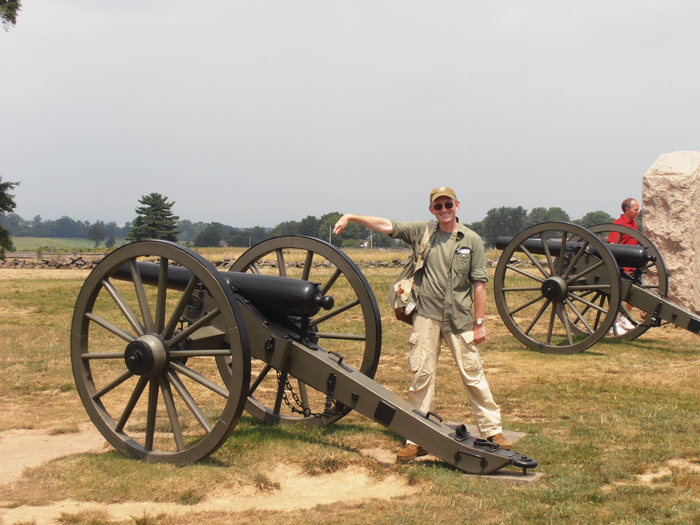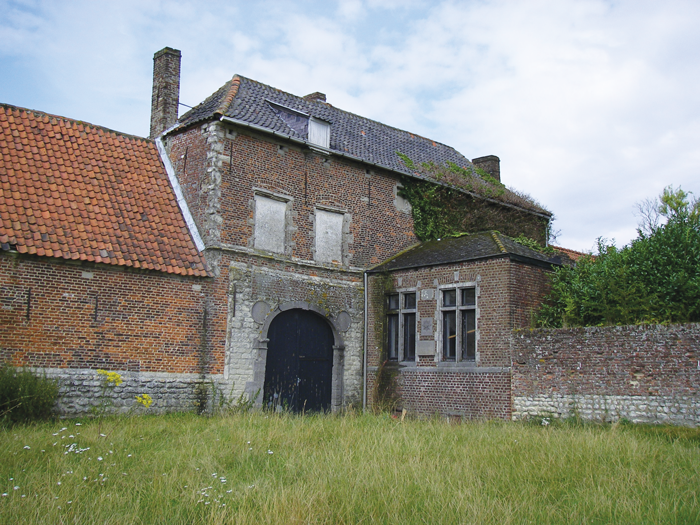We few, we happy few, we band of brothers;
For he to-day that sheds his blood with me
Shall be my brother; be he ne’er so vile,
This day shall gentle his condition:
And gentlemen in England now a-bed
Shall think themselves accursed they were not here,
And hold their manhoods cheap whiles any speaks
That fought with us upon Saint Crispin’s day.
(Wm Shakespeare; Henry V)
Now, I imagine that any female reader has more innate sense than to choose to march hundreds of miles through an Autumnal Northern France, starving and racked with dysentery and facing a battle, greatly outnumbered by your enemy…and yet, why the gents’ fascination with armed conflict? With twin sons, my wife vowed neither guns nor violent video games in our house. By two years of age they had already learnt to bite one corner out of their toast, to fashion an automatic pistol. As the years passed a succession of FIFAs from 2002 to 2014 never quite usurped Call of Duty, Rainbow Six etc. One tries.
Figure 1: Hougoumont, Waterloo.

Figure 2: Liam Flood with a cannon at Gettysburg.
War is hell
Warfare is about horror, is it not? Whether the wounded trapped in the burning barn of Hougoumont in 1815 (Figure 1), sailors succumbing, after surviving a month, in pitch darkness, below the waterline of Pearl Harbour (because no one heard them banging) or freezing in the steppes of Russia or the road to Corunna, the lot of those who serve is not to be envied. …and yet. A child of the ‘50s, I regarded as the ultimate in cool the P51D Mustang (The ‘Cadillac of the Skies’), the deck crew of US carriers of any era and the Flying Tigers’ leather jacket, with its Chinese back patch. On our third visit to Waterloo this Spring, we finally persuaded Mrs Flood to join us, but had to agree there is little to see (other than mud and a vast building site to commercially exploit the bicentenary next year). We dragged her across Gettysburg (far better preserved), whilst watching some very beefy locals pretending to be rebels of half their age and BMI (Figure 2). Last month’s holiday in Sorrento was only complete when I finally got to see the Gulf of Salerno…just to see across it, that was enough. You get the picture.
But if you can come through unscathed
This issue largely concentrates on how modern medicine tries to reverse the effect of high velocity impact on human tissues. Our esteemed editor decided it lacked an historical background and beseeched an article.
We face anniversaries for WWI, D Day (even as I type) and Arnhem to follow, VE Day and Waterloo next year, all of which the National Army Museum, London, has marked by closing for two years of course! In every TV interview the editor waits til the veteran’s account halts and silence gives way to a quiet tear of memory. They will then, every time, linger on that one sequence…and yet…. Those who do survive physically intact can find the return to humdrum civilian life challenging. Of course there is the post-traumatic stress disorder (PTSD), but also the feeling that, in daily danger of death, they had never felt more alive. Veteran’s Associations recall the comradeship, the bonding, possibly the sense of membership of an elite unit. A row of medals and a beret of any shade at a Remembrance parade commands our respect (provided, of course, you fought on our, the winning, side and, even then, only in a ‘just’ war).
Without war or the threat of it, I doubt I could have taken a jet propelled plane to Italy or driven to the airport in a four wheel drive Jeep, my satnav would surely have had no satellite orbiting in space to guide me, the local power station would still be running on coal, not nuclear fuel.
The myths of war
The truth is that the first planes to fall to Spitfires’ guns were Hurricanes. Pearl Harbour was really a miraculous escape, not a US disaster. Had the ships included the carriers and been sunk at sea, there would have been no salvage and few survivors. Had the US planes got off the tarmac, the far more irreplaceable pilots would have been massacred. Had the bombing concentrated on the fuel stores and not the ships, forget the War in the Pacific. Surprisingly the Central Powers came much nearer to victory in WWI (a war historians no longer regard as the poets’ waste) than the Axis ever did in WWII. The bookshops are now filled with such revisionist histories of warfare.
But let us concentrate on human beings, instead. Contrary to national stereotypes, the Italian Navy Special Forces were amongst the bravest and most effective units in modern war. The Kamikaze pilots were not suicidal. They did not seek out ‘martyrdom’, they just accepted that if you want to land a bomb on the island of an Essex Class carrier, but your plane is obsolescent and outclassed, the best way is….
Victor’s justice at Nuremberg is excused by the horrors it revealed, but war crimes can cross the front lines. Admiral Donitz was to be tried for ordering the murder of shipwrecked merchant crews by his U Boats, until Nimitz of the US Navy offered to testify that he had given the same instructions in the Pacific. Area bombing, the failure to rescue more Bismarck survivors, the number of wounded Zulu survivors at Rourke’s Drift (you can guess that one) were all results of entirely sound military decisions, or rather where there was no other choice, but equally and fortunately no video cameras, either.
Psychology and morale, not killing, is what wins wars, whether individual or national willpower. Patton famously said (although more ‘robustly’) “The object of war is not to die for your country but to make the other guy die for his.”
In the traditional pitched battle, the real casualty figures only started to mount once one side lost the will to fight and turned to run [1]. Squares were totally immune to cavalry (but alas were a massed target for artillery), just so long as the infantry stood. The riders might be daft enough, but no horse would approach the hedge of bayonets and gunfire presented [2]. Equally two lines of cavalry almost never collided in a charge, one side always, always, flinched first and was then slaughtered. Bayonet hand to hand ‘fighting’, unless in a built-up area, is almost unknown. The victim is usually fleeing or lying paralysed with fear, cowering in his trench, and has probably never even fired his weapon. Countries can refuse to accept defeat against all common sense. Russia against Napoleon, the USSR against the Axis, the US in the Pacific, Churchill’s British Empire all lost men, vast territory and equipment, but not the will to struggle on. By 1968 the US Forces had totally defeated the Viet Cong in the field and never did lose any engagement against the Regular NVA, but no one told Uncle Ho’s people that.
The medics
You will read then, in this issue, of the role of the doctor and medical services in war. Let us not forget also the evil that men do. For every Łucja Frey, the Polish neurologist known to us all for her syndrome, who disappeared in the Warsaw Ghetto, there is a Wegener, whose name may not even be used in describing his granulomatosis, due to his Nazi connections. Wellington’s Regimental Surgeons listed supervision of floggings as amongst their duties. Well meaning military surgeons have indeed often done as much harm as good. When that cannon ball passed with an inch or so of de Lancey on that ridge in Belgium, it may have missed him, but 12 pounds of metal displaces enough air to shatter your rib cage and contuse your lungs. He might have survived much longer than the week that did follow, had he not been copiously bled each day, as was custom and practice.
Our own John Hunter is arguably the father of British Military Surgery, a veteran of the Seven Years’ War. Sir Charles Bell (of Palsy fame) saw a wondrous opportunity on hearing of Waterloo and set off post haste across the Channel, to enhance his surgical experience [3]. One wonders if he spent as much time on his famous artwork of the injuries encountered, as on treating them? Larrey and his flying ambulance created a Napoleonic legend, even if Percy, arguably, contributed more to the welfare of the common Grognard [4]. Next time you are in the RSM, see that portrait of a very young Stuart Mawson (of Diseases of the Ear, for those too young to remember him) in full uniform and read Arnhem Doctor (which I once reviewed for ENT & audiology News) [5]. The Universal Soldier will continue to face horrors which we can only imagine and deserves our respect. If we are to think of bravery under fire, just recall that only three ‘Double VCs’ have been awarded, two to military doctors.
References
1. Stephenson M. The Last Full Measure ; How Soldiers Die in Battle. London, UK; Duckworth; 2013.
2. Muir R. Tactics and Experience of Battle in the Age of Napoleon. London, UK; Yale University Press; 1998.
3. Howard M. Wellington’s Doctors. Stroud, UK; The History Press; 2002.
4. Howard M. Napoleon’s Doctors. Kent, UK; Spellmount Ltd; 2006.
5. Mawson S. Arnhem Doctor. Kent, UK; Spellmount Ltd; 2007.
Declaration of Competing Interest: None declared.





